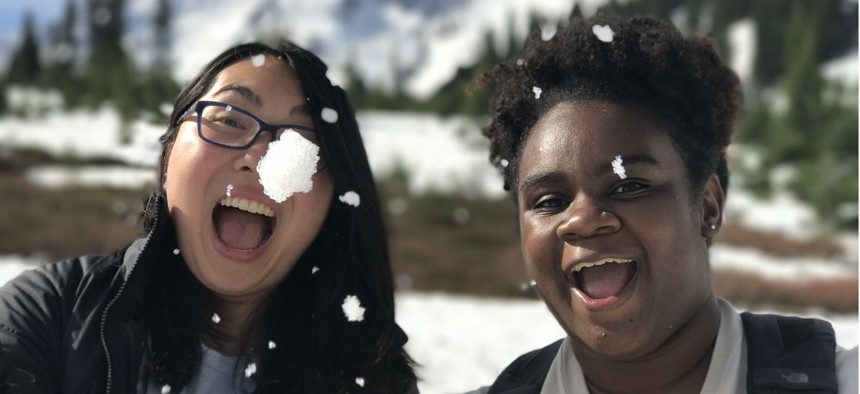
Chanara Andrews and Amanda Hsu served as interns with the National Park Service. NPS photo
What Are You Most Proud of This Year?
A challenge to look beyond metrics during the end-of-year reporting season.
There’s a question echoing through federal government offices in this end-of-year reporting season: “What are you most proud of this year?” Many of us are asking our employees this question as we wrap up their annual performance reviews. And many of our supervisors are asking us this question as they wrap up ours.
How meaningful are the answers?
“IT downtime was reduced by 25 percent.”
“Permit requests were processed 20 percent faster.”
“Vendor satisfaction increased by 15 percent.”
Legitimate accomplishments, but what if, instead of focusing on metrics like these, we strove to be more inspirational?
How about sharing a photo? Because a picture really can be worth a thousand words. One image can sometimes communicate your accomplishments more clearly. It might also inspire others.
“What am I most proud of this year?”
“Well, boss, let me show you.”
You see these two women playing in the snow at Mount Rainier National Park? I first saw this image when their supervisor shared it with me after an intern camping trip. Its power did not sink in until I saw it on Instagram a few weeks later, with a caption noting it was Chanara’s first time seeing snow in person. Through happy tears, I immediately recognized its power to illustrate the months, if not years, of budget planning, partner cultivation, and employee empowerment that made that moment possible.
Chanara Andrews and Amanda Hsu were interns (actually, “are” is more accurate since we strive to keep engaged with our interns long after their formal internships are complete). Chanara came to us from Spelman College through the Historically Black Colleges and Universities Internship program managed by the Greening Youth Foundation. Amanda joined us from the University of Washington through our In My Backyard youth conservation and leadership development program.
Chanara and Amanda are just two of the many interns, employees, volunteers, and partners playing key roles in furthering our goals to reach new audiences, raise awareness of the National Park Service, and facilitate a sense of belonging.
Clearly they had a good time! They also worked hard and made significant contributions. Chanara designed a high school mentorship program to engage historically underrepresented communities so they are affirmed in their belonging not only in their national parks, but in environmental education and environmental justice as well. Amanda designed a community outreach mobile park to engage with people at events new to the National Park Service, such as Dragon Fest, a large pan-Asian celebration in Seattle’s Chinatown-International District.
They also both published essays about their internships in weekly newspapers that target readers the National Park Service must connect with if it hopes to achieve relevancy for all Americans. Chanara’s “National Parks Intern Shares Her Experience in Seattle” was published in the Seattle Medium – part of the largest African American owned and operated communications company in the Pacific Northwest. Amanda’s “Creating a Sense of Belonging in our National Parks” appeared in the Northwest Asian Weekly – which has the goal “to empower the Asian community.”
For me, this picture of Chanara and Amanda serves as a powerful reminder of what they and our team accomplished and as a compass for where we can go from here. I keep it on my desk to both inspire and challenge me to do more.
My challenge to you – as you generate numbers, evaluate results, and prepare for your performance reviews – is to pause, reflect, and look for photos.
I think you will discover accomplishments more inspirational than what the numbers have to tell you. A photo can not only convey more meaning, it can also save you a thousand words of end-of-year reporting.
Charles Beall is Superintendent of Seattle Area National Park Sites, three national parks managed by the National Park Service and its partners to share stories of Seattle’s past, present, and future: Klondike Gold Rush National Historical Park – Seattle Unit, Bainbridge Island Japanese American Exclusion Memorial (a unit of Minidoka National Historic Site), and Wing Luke Museum of the Asian Pacific American Experience (an affiliated area of the National Park System).






